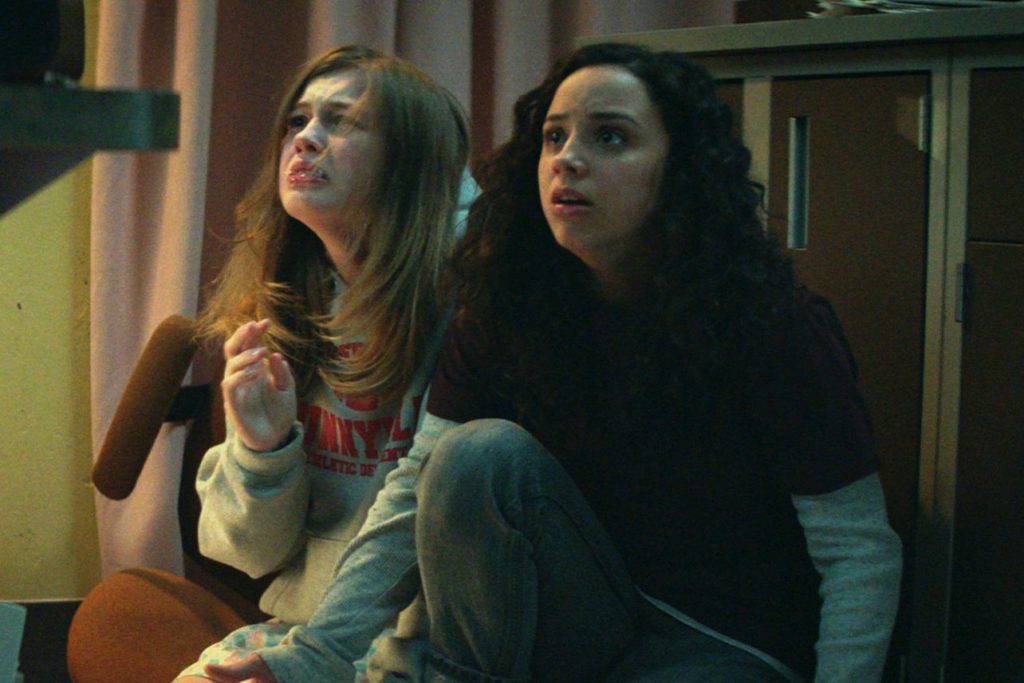Directed by Leigh Janiak and adapted from R.L. Stine’s books, Netflix’s Fear Street trilogy tells an episodic story through three films, with each film taking place in a different time period and paying homage to a different type of horror film.
Feat Street Part One: 1994 starts things off by giving us the lay of the land. Two towns, Shadyside and Sunnyvale, have been at odds for three hundred years, with Sunnyvale prospering while Shadyshide is stuck in a perpetual rut and plagued by a series of murderers. All of these murderers are seemingly normal until they seem to snap. Deena (Kiana Madeira) is mad at her ex Sam (Olivia Scott Welch) for abandoning her and moving to Shadyside. However, a chance encounter with the (alleged) witch Sarah Fier’s remains attracts a bevy of resurrected killers who can’t seem to die. Deena and her friends try to survive and save Sam from dying, as the killers seem to be attracted to her blood.

What makes the first part work is that it balances the slasher moments with character work. None of the characters fit into typical stereotypes- Kate (Julia Rehwald), for instance, is a cheerleader who also happens to be a drug dealer. The film reaches a crescendo with its climax, but just as you think things are fine, they ramp up again, setting up the sequels.
Fear Street Part Two: 1978 goes back a few decades as Deena and Josh track down the survivor of the last massacre at camp Nightwing, C Berman (Gillian Jacobs) and learn what happened. We catch up with sisters Ziggy (Sadie Sink) and Cindy Berman (Emily Rudd), as they adopt different strategies to go through the hell that is teenage years. Things go wrong pretty fast when the camp is attacked by an ax-crazy murderer, who is none other than Tommy (McCabe Sly), Cindy’s boyfriend. There were early warning signs, as the camp nurse, Mary Lane (Jordana Spiro), tried to stab him earlier in the day. The sisters try to break the curse by reuniting Sarah Fier’s hand with the rest of her body, but unfortunately the body was missing. The film’s climax throws us a twist that seems obvious in retrospect.
You might not like 1978 as much as the first one, as it’s a little bit more scattered. The characters aren’t as memorable this time around, but at least the slasher scenes deliver. Like the first film, 1978 also dabbles in too many needle drops, liberally dishing out 70s hits. It gets repetitive after a while.
Fear Street Part Three: 1666 goes back to the genesis of the curse plaguing Shadyside. Actors from the first two films return as new characters some in familiar roles. Sarah Fier (Kiana Madeira) feels guilty after a forbidden affair with Hannah (Olivia Scott Welch) seemingly leads to pestilence and madness in the town of Union. Sarah is soon called out as a witch and the townsfolk eventually find her and lynch her. In 1994, Deena realizes the truth of who had started the curse and embarks on a final quest to kill the descendant of the culprit and save Sam.
The shift from 1666 to 1994 Part 2 is a bit jarring. There is an ominous air in the first section, and it almost acts as a commentary on how people who didn’t fit with social mores were branded as pariahs and scapegoats when people in a crisis looked for easy answers. The ending almost feels like a different take on Stranger Things, and while things do look up for the characters, the film alludes to further stories, which makes sense, since there are more than a hundred Fear Street stories.
Janiak isn’t trying to reinvent the wheel with this trilogy. It’s fun, driven by an engaging mystery and the slasher scenes are more than adequate. If you’re looking for something gruesome that also has a decent story, you should give this a try.